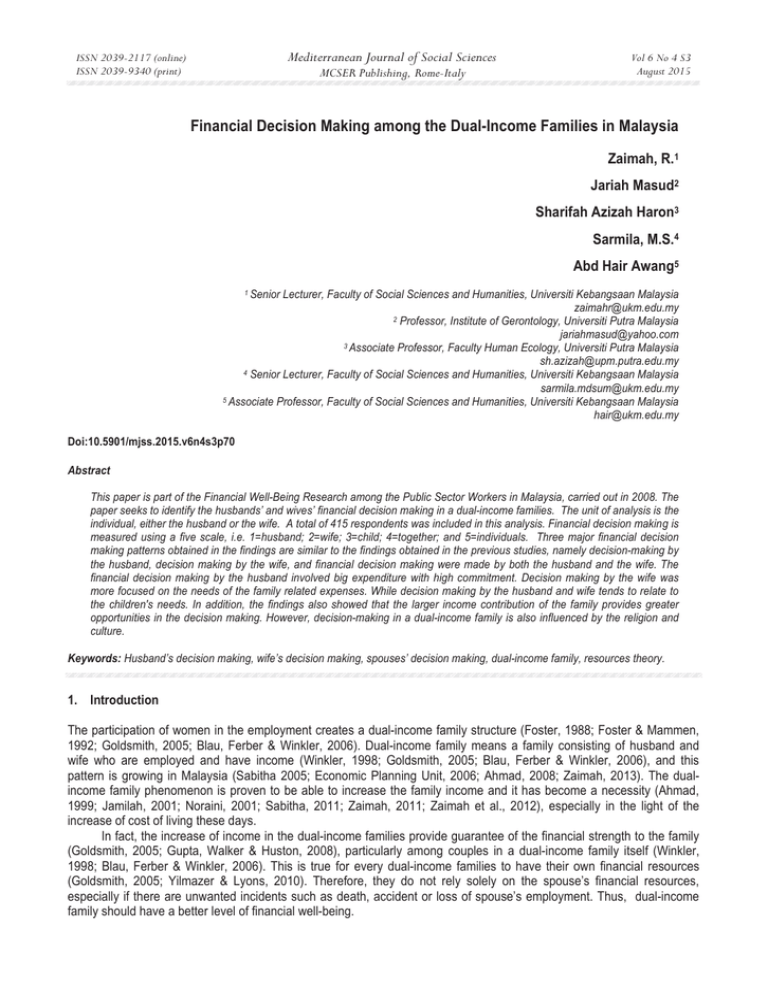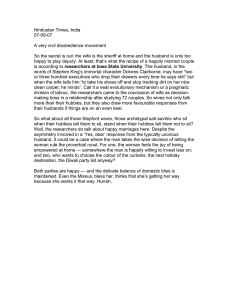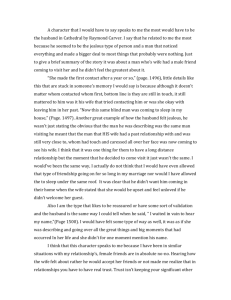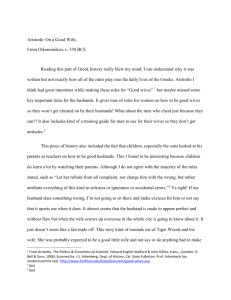
Mediterranean Journal of Social Sciences
ISSN 2039-2117 (online)
ISSN 2039-9340 (print)
MCSER Publishing, Rome-Italy
Vol 6 No 4 S3
August 2015
Financial Decision Making among the Dual-Income Families in Malaysia
Zaimah, R.1
Jariah Masud2
Sharifah Azizah Haron3
Sarmila, M.S.4
Abd Hair Awang5
Senior Lecturer, Faculty of Social Sciences and Humanities, Universiti Kebangsaan Malaysia
zaimahr@ukm.edu.my
2 Professor, Institute of Gerontology, Universiti Putra Malaysia
jariahmasud@yahoo.com
3 Associate Professor, Faculty Human Ecology, Universiti Putra Malaysia
sh.azizah@upm.putra.edu.my
4 Senior Lecturer, Faculty of Social Sciences and Humanities, Universiti Kebangsaan Malaysia
sarmila.mdsum@ukm.edu.my
5 Associate Professor, Faculty of Social Sciences and Humanities, Universiti Kebangsaan Malaysia
hair@ukm.edu.my
1
Doi:10.5901/mjss.2015.v6n4s3p70
Abstract
This paper is part of the Financial Well-Being Research among the Public Sector Workers in Malaysia, carried out in 2008. The
paper seeks to identify the husbands’ and wives’ financial decision making in a dual-income families. The unit of analysis is the
individual, either the husband or the wife. A total of 415 respondents was included in this analysis. Financial decision making is
measured using a five scale, i.e. 1=husband; 2=wife; 3=child; 4=together; and 5=individuals. Three major financial decision
making patterns obtained in the findings are similar to the findings obtained in the previous studies, namely decision-making by
the husband, decision making by the wife, and financial decision making were made by both the husband and the wife. The
financial decision making by the husband involved big expenditure with high commitment. Decision making by the wife was
more focused on the needs of the family related expenses. While decision making by the husband and wife tends to relate to
the children's needs. In addition, the findings also showed that the larger income contribution of the family provides greater
opportunities in the decision making. However, decision-making in a dual-income family is also influenced by the religion and
culture.
Keywords: Husband’s decision making, wife’s decision making, spouses’ decision making, dual-income family, resources theory.
1. Introduction
The participation of women in the employment creates a dual-income family structure (Foster, 1988; Foster & Mammen,
1992; Goldsmith, 2005; Blau, Ferber & Winkler, 2006). Dual-income family means a family consisting of husband and
wife who are employed and have income (Winkler, 1998; Goldsmith, 2005; Blau, Ferber & Winkler, 2006), and this
pattern is growing in Malaysia (Sabitha 2005; Economic Planning Unit, 2006; Ahmad, 2008; Zaimah, 2013). The dualincome family phenomenon is proven to be able to increase the family income and it has become a necessity (Ahmad,
1999; Jamilah, 2001; Noraini, 2001; Sabitha, 2011; Zaimah, 2011; Zaimah et al., 2012), especially in the light of the
increase of cost of living these days.
In fact, the increase of income in the dual-income families provide guarantee of the financial strength to the family
(Goldsmith, 2005; Gupta, Walker & Huston, 2008), particularly among couples in a dual-income family itself (Winkler,
1998; Blau, Ferber & Winkler, 2006). This is true for every dual-income families to have their own financial resources
(Goldsmith, 2005; Yilmazer & Lyons, 2010). Therefore, they do not rely solely on the spouse’s financial resources,
especially if there are unwanted incidents such as death, accident or loss of spouse’s employment. Thus, dual-income
family should have a better level of financial well-being.
ISSN 2039-2117 (online)
ISSN 2039-9340 (print)
Mediterranean Journal of Social Sciences
MCSER Publishing, Rome-Italy
Vol 6 No 4 S3
August 2015
Apart from the likely of achieving a better financial well-being, the dual-income family structure are expected to
cause changes in the financial decision making patterns within the family as both the husband and wife contribute income
to the family (Edgel, 1980; Grossbard-Shectman, 2001; Bernasek & Bajtelsmit, 2002; Samsinar, Wong, Ruhana et al.,
2004). Thus, this research aims to identify the dual-income family’s financial decision making patterns in Malaysia. More
specifically, the study will discuss the financial decision making patterns by the husband, financial decision making by the
wife, and also financial decision making by both the husband and the wife.
2. Literature Review
Financial decision making is defined as the individual's authority to a financial decision making and is usually described in
terms of the pattern of financial decision making, whether it is done jointly between the husband and wife, or one of the
more dominating (Bernasek & Bajtelsmit, 2002).
2.1
Financial decision making
Financial decision making involves the relationship between money and power in the family, especially in the dual-income
families. The relationship has a certain direction, i.e. those who have incomes will have a major influence in the family
decision-making (Hertz, 1992). If the assumption is true, the phenomenon of the increasing participation of women
(wives) in employment and contributing to the family income will produce a different pattern of decision-making for
couples who are both working.
According to Safilios-Rothschild (1969 in Edgel 1980) who has studied the decision making among professional
workers and their wives finds that, very important decision tend to be dominated by the husband. Between the important
and not important decisions, the decision was jointly made. Financial related decision making that is categorized as the
most important perception is made by the husband. In other words, husband has more opportunities in making decisions
involving important things (that involve large amount of money), while the wife only had the opportunity to make decisions
in small matters.
Normally, the family financial management has two main features, namely the one who has the power to make
decisions and who manage their finances. Decision-making authority is usually described in terms of the pattern of
financial decision making, whether it is done jointly between the husband and wife, or by dominating ones. In many
instances, women were found to be playing a bigger role as a financial manager in the family (Coleman & Ganong, 1989;
Muske, 1995; Muske & Winter, 2001).
Financial decision making is associated with the distribution of financial resources within a family, and it depends
on who has the source of income in the family (Grassbard-Shectmen, 2003). In fact, the authority or the right of an
individual in making financial decision also has an impact on the relationship and financial well-being, especially in terms
of financial satisfaction (Bernasek & Bajtelsmit, 2002). That means, the opportunity to make decisions in matters related
to finance also gave financial satisfaction.
In the context of financial decision-making, women who work outside the home, have income and own property
has the advantage of expression in the family financial decision making compared to those who do not have their own
sources of income (Grassbard-Shectmen, 2003). The possibility for a wife to have more power in the financial decision
making process has a significant effect of about 20 to 25 percent amongst dual-income couples if the wife has a higher
income than their husbands (Winkler, 1998).
The findings by Bernasek and Bajtelsmit (2002) concluded that, women participation in the family financial decision
making are significant and have a positive relationship with the contribution of their income to the family. Women will have
more power to make financial decision if she contributes a significant share to the family income. But women are less
instrumental in making decisions related to the family savings and investments. Instead, men are more likely to make
financial decision in the family when their level of education, level of income and financial assets are higher than the
women (Lindamood & Hanna, 2006).
Samsinar et al. (2004) described that the gender factor also plays an important role in the family decision making.
Their study found that women also have an important role in purchasing decision making in the family. Normally, the
husband and wife will decide collectively in making decisions pertaining to the purchasing of goods or spending money to
the family. Therefore, it is difficult to determine the specific factors that influence the decision-making patterns (Samsinar
et al., 2004). In addition, women were prefer to avoid risks in the financial decisions making than men even if they
acquire greater financial resources than men (Stendardi & Graham, 2000; Yilmazer & Lyons, 2010). For example,
Yilmazer and Lyons (2010) found that married women who have greater power to the family's financial resources are less
ISSN 2039-2117 (online)
ISSN 2039-9340 (print)
Mediterranean Journal of Social Sciences
MCSER Publishing, Rome-Italy
Vol 6 No 4 S3
August 2015
keen to invest in risky assets.
Study by Mano-Negrin and Katz (2003) on the employed spouses economic behavior found that there were three
patterns of spouse’s income distribution, that are, the traditional couples, modern couples and individualistic couples. The
traditional couples do not share their income, but have accounts that are jointly managed. Modern couples share the
income, but have separate accounts. Whereas individualistic couples do not share their income and have separate
accounts. However, modern couples claim that they often make their own decisions when they make a purchase or invest
their earnings.
In summary, the previous studies found that spouses often make joint decisions in matters pertaining to housing,
education, recreation, medical and family expenses (Deacon & Firebough, 1988). Men have the higher level of financial
well-being than women because they have the opportunity to enjoy higher income and receive more pension (Davis,
1993). In fact, significant differences exist between men and women in the purchasing behavior and financial satisfaction.
The fact is, men have greater authority in the financial decision making that also affect the financial well-being.
2.2
Theoretical framework
The theory of resources was introduced by Robert Blood and Donald Wolfe in 1960. Most of the studies on power in
marriage were using this theory as a framework for research (Rodman, 1972; Straus & Yodanis, 1995; Peyton, Pitts &
Kamery, 2004). The resources theory asserts that the 'balance of power' in decision-making would be in favor of the
spouse who contributed the most resources in the marriage relationship. The family members who have vast resources to
meet the needs and goals of other family members were designated as having greater power.
In fact, the power of women in decision-making is assumed to increase with the increasing resources contributed
to the family. It means, resources contributed by the spouse in the family has a significant impact on the financial decision
making. According to Blood and Wolfe (1960), decision-making was found to be directly proportioned to the income,
education and occupational status.
On the other hand, Rodman (1972) failed to prove the main assumptions of the theory. His research shows that the
husband's occupation, education and income status were negatively related to the power that belongs to the family.
Therefore, he treated that the relations between resources with the marriage power is dependent on the role of the
gender which is also influenced by the socio-cultural factors in the local community (Ahmad, 1999; Norzareen & Nobaya,
2010; Kaur, 2008).
In addition, Bonke (2008) found that the contribution of the income between the husband and the wife in the family
also affects the financial satisfaction. Their study found that the husband’s financial satisfaction decreases and the wife’s
financial satisfaction increases when the wives earned more than their husbands.
3. Research Methodology
This paper seeks to identify the pattern of the dual-income families financial decision making among the public sector
workers who are married. The data used in this study were from a study of the Financial Well-being among public sector
in Malaysian, 2008. Discussions involving the results of analysis on 415 respondents among the employees of the dualincome families. The questionnaire was used as an instrument in this study. Respondents are required to answer a 'who
most often' make decisions about spending money on the 14 related financial decisions in the family, namely food, meals
and beverages outside the home, clothing and footwear, communication equipment, household electrical appliances,
furniture/home furnishings, vehicles, real estates, medical, education, life insurance, education insurance, family
vacations, and contribution to the parents. Financial decision making is measured using a five scale, i.e. 1=husband;
2=wife; 3=child; 4=together; and 5=individuals. Factor analysis was used to classify the 14 items used to measure the
financial decision making. Financial decisions making score were derived from the total score of husband’s financial
decisions and the total score of wives’ financial decisions of 10 statements (only 10 items accepted after factor analysis
was conducted). While descriptive analysis (frequency, percentage, mean and standard deviation) was used to analyse
the data for overall discussion. The ANOVA test was used to compare the financial decision making based on the
husband’s and wife’s income contribution to the family.
Mediterranean Journal of Social Sciences
ISSN 2039-2117 (online)
ISSN 2039-9340 (print)
Vol 6 No 4 S3
August 2015
MCSER Publishing, Rome-Italy
4. Findings and Discussion
4.1
Socio-economic backgrounds of respondent
The socio-economic background of the respondent is shown in Table 1. Among the 415 respondents, 47 percent were
male and 53 percent were female. The average age of the respondents was 38 years old. In particular, approximately
50 percent were in the age range of less than 40 years old. Although the average years of marriage among the
respondents were 11 years, more than half (55.4 percent) of the respondents were married less than 10 years. The
average number of children was 2 persons. Meanwhile, the average of working years was 13 years and the data showed
the highest percent (51.6%) within less than 10 years. It was consistent with the data that showed more respondents
were among the younger age.
The majority of respondents were non-universities graduates (59.8%) and only 40.2 percent were graduates. More
male respondents (51.8%) were graduates compared to female (30.0%) respondents. The average monthly income of
the respondents was RM3,579.00. It involved 40 percent from middle income family in Malaysia, range from RM2,300.00
to RM5,599.00 (Economic Planning Unit, 2010). The average monthly expenses of the respondents was RM2,372.00.
The finding showed that the husband still held the responsibility as the breadwinner in dual-income families.
Among the total number of respondents, nearly 55 percent of the respondents owned their own house. The
average monthly house loan payment is RM726.50 with the range from RM140.00 and RM3,000.00. The husband
contributed more to the family income (64.1%) compared to the wife. The equal sharing of income between husband and
wife showed a low percentage (11.0%). The portion from the wife only amounted up to 24.8 percent. If a comparison is
made between male respondents and female respondents, the three categories of income contribution shows the same
pattern, the husband contributed more income than his wife even though both of them were working.
Table (1). Socio-economic background of respondent
Socio-economic background
Gender:
Male
Female
Age
Duration of marriage
Number of children
Duration of work
Level of education:
University graduates
Non graduate
Monthly income (RM)
Monthly expense (RM)
Home ownership
Contribution to family income:
Husband > wife
Husband = wife
Husband < wife
4.2
Frequency (%)
Mean (S.D.)
195 (47.0)
220 (53.0)
-
38 (9.45)
11 (9.18)
2 (1.77)
13 (10.20)
166 (40.2)
249 (59.8)
-
3579 (2421.39)
2372 (1575.37)
228 (54.9)
266 (64.1)
46 (11.1)
103 (24.8)
-
Distribution of the dual-income family’s financial decision making
Table 2 shows the pattern of the financial decision making in the family. Financial decision making by the husband who
had the highest percentage can be seen in eleven cases, namely meals outside the home (56.6%), communication
equipment (61.9%), household electrical appliances (52.0%), vehicles (78.3%), real estates (66.3%), medicine (47.1%),
children’s education (39.3%), life insurance (54.2%), education insurance (43.9%), family vacations (44.1%) and money
for the parents (39.3%). Six of them recorded percentage share that exceeds 50 percent. In general, these findings
clearly show that men have more power in the financial decision making, especially those involving large expenditures
and high commitments.
ISSN 2039-2117 (online)
ISSN 2039-9340 (print)
Mediterranean Journal of Social Sciences
Vol 6 No 4 S3
August 2015
MCSER Publishing, Rome-Italy
Table (2). Distribution of the dual-income financial decision making
Financial decision making (FDM)
1.
2.
3.
4.
5.
6.
7.
8.
9.
10.
11.
12.
13.
14.
Food and beverages.
Meal outside the home.
Clothing and footwear.
Communication equipment.
Household electrical appliances.
Furniture/home furnishings.
Vehicles.
Real estates.
Medicine.
Children education.
Life insurance.
Education insurance.
Family vacations.
Money for the parents.
Husband
111(26.7)
235(56.6)
90(21.7)
257(61.9)
216(52.0)
108(26.0)
325(78.3)
275(66.3)
196(47.2)
163(39.3)
225(54.2)
182(43.9)
183(44.1)
163(39.3)
Wife
259(62.4)
108(26.0)
253(61.0)
82(19.8)
152(36.6)
248(59.8)
39(9.4)
56(13.5)
144(34.7)
143(34.5)
93(22.4)
119(28.7)
143(34.5)
132(31.8)
Frequency (%)
Children
Joint
2(0.5)
43(10.4)
11(2.7)
60(14.5)
7(1.7)
54(13.0)
16(3.9)
52(12.5)
4(1.0)
42(10.1)
3(0.7)
54(13.0)
6(1.4)
42(10.1)
1(0.2)
81(19.5)
2(0.5)
70(16.9)
3(0.7)
106(25.5)
1(0.5)
95(22.9)
6(1.4)
107(25.8)
5(1.2)
83(20.0)
1(0.2)
107(25.8)
Individual
0(0.0)
1(0.2)
11(2.7)
8(1.9)
1(0.2)
2(0.5)
3(0.7)
2(0.5)
3(0.7)
0(0.0)
1(0.2)
1(0.2)
1(0.2)
12(2.9)
On the other hand, the financial decision making by the wife which recorded the highest percentage share involved only
three things, namely food and beverages (62.4%), clothing and footwear (61.0%) and furniture/home furnishings (59.8%).
Percentage of more than 50 percent in the decision-making also explained that the wife, despite working, only has the
'authority' to make financial decisions that are 'in the family' only. The socio-cultural factors perceived as affecting many
of these findings, given that 94.5 percent of the respondents are the Malay Muslims.
Meanwhile, there is no higher share for the husbands’ and wives’ joint financial decision making. Although the
study subjects are married public sector workers (in dual-income families), the jointly financial decision making patterns is
not prominent in this study. The cause of the findings cannot be ascertained. Interestingly, there are also individual’s
financial decisions making, that were made on the same matter. In general, it seems to reflect the individualistic nature
among the couples involved. However, it is also not prominent in this finding.
After conducting the factor analysis, four items were eliminated from the 14 items that measure the respondents’
financial decision making (FDM), that is, real estates (FDM8), medicine (FDM9), family vacations (FDM13) and money for
the parents (FDM14). The analysis factors result indicates that the items measuring the financial decision making can be
broken into two constructs, namely the decision making on family basic expenses and the expenditure on protection
(insurance) decision-making. If it is refined according to the construct, the husbands still dominate the decision-making on
both aspects compared to the wives with each recording; family basic expenses (husband=46.20%; wife=39.28%) and
insurance expenses (husband=45.78%; (wife=28.51%) respectively.
4.3
Dual-income family financial decision-making patterns
Figure 1 shows the pattern of the respondents' financial decisions making. This pattern is obtained by summing all the
decision making frequencies for the husband, wife, child, together and individually. The results show that the financial
decision making in the respondent’s family is dominated by the husbands (46.07%) than wives (34.05%). The husbands
and wives financial decision making were low (15.78%). While the financial decision making by the children and
individuals recorded only about one percent. If referred to the perceptions of the respondents to the question 'decision
makings related to spending money in the family should be whose responsibility”, the findings recorded husbands
(57.6%), wife (9.6%) and jointly (32.8%). This finding indicates that the respondent’s practice and perception are not in
congruent. This finding explains that the husband still dominates the financial decision making even though his wife had
contributed income to the family.
ISSN 2039-2117 (online)
ISSN 2039-9340 (print)
Mediterranean Journal of Social Sciences
MCSER Publishing, Rome-Italy
Vol 6 No 4 S3
August 2015
Figure (1). The patterns of the respondents’ financial decision making.
Figure 2 specifically shows the respondents’ financial decision making by the husbands and wives and jointly (husbandwife). The three most important financial decision making made by the husbands are related to the purchase of vehicles
(FDM7), communication equipment (FDM4) and meals outside the home (FDM2). While the most important financial
decision made by the wife involved the financial decisions related to food (FDM1), clothing/footwear (FDM3) and
furniture/home furnishings(FDM6).
Figure (2). The respondents’ financial decision-making
While the highest percentage of financial decision makings that are jointly made involved the financial decision related to
the children’s education, education insurance, and life insurance. This supports the findings of Safilios-Rothschild (1969)
in Egdel (1980), Grassbard-Shectman (2001), Bernasek and Bajtelsmit (2002) and Lindamood and Hanna (2006), that is
an important decision that involves large expenditures are dominated by the husbands. While the less important involving
little expenditures were made by the wives.
4.4
Husbands’ and wives’ Financial Decision Making Score
The total financial decision making score made by the husbands and wives out of the 10 measured items are shown in
Figure 3. The highest score of the husband’s financial decision making is six (17.8%). While the highest wives’ financial
decision making score is four (18.8%). Once again, this explains that the husband has an advantage in the family
financial decision making process.
Figure (3). The total financial decision making score
ISSN 2039-2117 (online)
ISSN 2039-9340 (print)
Mediterranean Journal of Social Sciences
Vol 6 No 4 S3
August 2015
MCSER Publishing, Rome-Italy
The following discussion is focused on the minimum score of the financial decision making (score 0) and maximum (score
10). By looking at the husband’s '0' score, it was found that eight husbands (72.7%) are not university graduates, seven
husbands (63.6%) hold positions in the support group and seven (63.6%) of them contributed higher income share to the
family than the wives. While for the wife’s score of '0', nine wives (75.0%) are not university graduates and hold positions
in the support group. Only two wives (16.7%) contributed larger income than the husband in the family.
Referring to the husbands’ score of ‘10’, it was found that 23 husbands (62.2%) had non-university education, 24
husbands (64.9%) in the category of support group and 23 husbands (62.2%) contributed greater income than the wife in
the family. While for the wives’ score of '10' it was found that 16 (59.3%) had non-university education and 17 wives
(64.0%) hold positions in the support group. In this situation, only five wives (18.5%) contributed greater income than the
husband in the family.
Based on the descriptive analysis of the score of '0' and a score of '10' discussed above, it was found that resource
factors (financial) alone do not give absolute power in the financial decision making in the family. Instead, there are other
factors that influence the financial decision making in the family, such as religious factor, culture and ethnicity (Rodman
1972). The religious factors are among the contributors to the decision making, because in Islam, the husband is the
head of the family.
4.5
Comparison of financial decision making by husband and wife
Table 3 shows a comparison of the mean scores for the husband’s financial decision making to the contribution of the
family income. The results of the ANOVA test showed significant differences [F(df=2,502, p<.05)=3.620] between the
average scores of the husband’s financial decision making according to the family income contribution. However, the
Tukey test results show only the difference score for the husband’s financial decision making were significant (p=.028) on
the husband’s contribution of the family income 'more than' the wife (6.41) and only the contribution of the family income
‘husband less than the wife’ (5.65).
Table (3). The ANOVA test results on the mean score of the husband’s financial decision making according to the
husband's family income contribution.
Contribution to family income
Husband > Wife
Husband = Wife
Husband < Wife
** Significant at p<.05
n
266
46
103
Mean
6.41
6.07
5.65
Standard Deviation
2.43
2.26
2.62
F value
Significant
3.620
.028**
Table 4 shows a comparison of the mean score of the wife’s financial decision making with the family income
contribution. ANOVA test results show that there are significant differences [F(df=2578, p<.05)=5.102] between the
average score for the wife’s financial decision making according to the wife’s family income contribution. This finding
means that the wife who has income in excess of the husband’s income had more opportunities in the family financial
decision making. The Tukey test shows that the differences in the average score of the wife’s financial decision making is
just significant (p =.001) only on the contribution of the family income ‘husband more than wife’ (4.89) and the contribution
of the family income ‘husband less than wife’ (5.75).
Table (4). The ANOVA test results on the mean score of the wife’s financial decision making according to the family
income contribution.
Contribution to family income
Husband > Wife
Husband = Wife
Husband < Wife
** Significant at p<.05
n
266
46
103
Mean
4.89
5.61
5.75
Standard Deviation
2.57
2.51
2.31
F value
5.102
Significant
.006**
Based on the above results of the ANOVA test, on the mean score of the financial decision making on a husband and
wife, it was found that resource factor (finance) has a relationship with the family financial decision making. The husband
or wife who has a greater income than the spouse in the family has an advantage in the financial decision making. This is
ISSN 2039-2117 (online)
ISSN 2039-9340 (print)
Mediterranean Journal of Social Sciences
MCSER Publishing, Rome-Italy
Vol 6 No 4 S3
August 2015
in line with the assumptions of the Resources Theory (1964) and also the findings of past studies, such as Bernasek and
Bajtelsmit (2002) and Lindamood and Hanna (2006). However, the religion, culture and ethnicity also have influence in
the financial decision making in a family, even if both husband and wife work and contribute to the family.
5. Conclusions
The financial decision making patterns among the respondents are still similar to the previous findings, i.e. financial
decision making is dominated by either husband, wife or husband-wife. There are also decision making made by the
children and individuals, but the percentage is very low and is insignificant to be featured in this study. Financial decision
making dominated by the husband are decisions involving large expenses and high commitments, such as an
investment. While the financial decision making dominated by the wife is closely related to the expenses pertaining to the
needs and the importance of the family. While the collective decision making of the spouses are more directed to the
needs of the children. In total, there are three main patterns of the financial decision making (FDM) in the family that is;
husband’s FDM, wife’s FDM and FDM by the spouses. However, the husband still has the advantage of the financial
authority in decision making in the dual-income family.
6. Acknowledgment
The authors would like to thank and appreciate Universiti Kebangsaan Malaysia for providing of research funding under
Grant UKM-SK-21-2007: Financial well-being among public sector in Malaysia 2008.
References
Ahmad, A. (1999). Gender Role Orientation of Husbands and Work-Family Conflict of Wifes in Dual-Earner Families. Pertanika Journal
of Social Science and Humanities. 7(1): 1-9.
Ahmad, A. (2008). Direct and Indirect Effect of Work-Family Conflict on Job Performance. The Journal of International Management
Studies. 3(2): 176-180.
Bernasek, A. & Bajtelsmit, V. L. (2002). Predictors of women’s involvement in household financial decision-making. Association for
Financial Counseling and Planning Education, 13(2):39-47.
Blau, F. D., Ferber, M. A. & Winkler, A. E. (2006). The Economics of Women, Men, and Work. 5th edition. New Jersey: Pearson
Prentice Hall.
Blood, R. O. & Wolfe, D. M. (1960). Husband and wife: the dynamics of married living. Glenceo: The Free Press.
Bonke, J. (2008). Income distribution and financial satisfaction between spouses in Europe. The Journal of Socio-Economics. 37:
2291-2303.
Coleman, M. & Ganong, L. H. (1989). Financial management in step families. Lifestyles: Family and Economic Issues, 10(3):217-232.
Davis, D. S. (1993). Financial security of urban retirees. Journal of Cross-Cultural Gerontology, 8:179-195.
Deacon, R. E. & Firebough, F. M. (1988). Terj. Nurizan Yahaya dan Mumtazah Othman. Pengurusan sumber keluarga: prinsip dan
aplikasi. Serdang: Penerbit UPM.
Economic Planning Unit. (2006). 9th Malaysian Planning 2006-2010. Prime Minister Department of Malaysia.
Foster, A.C. & Mammen, S. (1992). Impact of wife’s employment on service expenditures. Journal of Consumer Studies and Home
Economics. 16:9-18.
Goldsmith, E.B. (2005). Resource Management for Individuals and Families. 3rd edition. United States: Thompson Wadsworth.
Grossbard-Schectman, S. (2001). The new home economics at Columbia and Chicago. Feminist Economics, 7(3):103-130.
Gupta, A. E., Walker, T. & Huston, A. (2008). Working Families Should Not Be Poor. In Crane, D. R. & Heaton, T. B. Handbook of
families and poverty (pp.32-47). London: SAGE Publications.
Hertz, R. (1992). Financial Affairs: Money and Authority in Dual-Earner Marriage. Dalam Lewis, S., Izraeli, D. N. & Hootsmans, H.
Dual-earner families: international perspectives (pp.127-150). London: SAGE Publications.
Jamilah Ariffin. (2001). The changing Malaysian family: tracing its changes through trend data and research findings. In Jamilah Ariffin
dan Adeline Louis (pnyt). Family well-being: learning from the past for the betterment in the future. ISI Publication.
Kaur, S. (2008). Women at work: work family conflict and wellbeing. Pertanika Journal Social Science dan Humanity. 16(2): 257-268.
Lindamood, S. & Hanna, S. D. (2006). The more financially knowledgeable person in older couple households. Consumer Interests
Annual, 52:315-330.
Mano-Negrin, R. & Katz, R. (2003). Money management of dual-earner families in Israel. Journal of Family and Economic Issues,
24(1):49-72.
Muske, G. (1995). Family financial management: a case study from the perspective of the money manager. Family Economics and
Resource Management Biennial, 129-134.
Muske, G. & Winter, M. (2001). An in-depth look at family cash-flow management practices. Journal of Family and Economic Issues,
22(4):353-372.
ISSN 2039-2117 (online)
ISSN 2039-9340 (print)
Mediterranean Journal of Social Sciences
MCSER Publishing, Rome-Italy
Vol 6 No 4 S3
August 2015
Noraini, M. N. (2001). Work, Family and Women’s Well-Being: Challenges of Contemporary Malaysian Women. IIUM Press Malaysia.
Norzareen, M. & Nobaya, A. (2010). Women of the sandwich generation in Malaysia. European Journal of Social Sciences. 13(2):
171-178.
Peyton, R. M., Pitts, S. T. & Kamery, R. H. (2004). The family decision-making process: a review of significant consumer satisfaction/
dissatisfaction models. Academy of Marketing Studies Journal. http://findarticles.com/p/articles/mi_hb6167/is_1_8/ai_n29153
589/ ?tag=content;co11. Assesed on 23rd November 2010.
Rodman, H. (1972). Marital power and the theory of resources in a cross-cultural context. Journal of Comparative Family Studies, 1:5061.
Sabitha Marican. (2005). Membentuk Suasana Kerja Positif: Aspek Hubungan Manusia dan Persekitaran Sosial. Kuala Lumpur: Utusan
Publications & Distributors.
Sabitha Marican. (2011). Wanita Lebih Banyak Alami Stress Mental? Mingguan Malaysia, 23 Januari, 2011.
Samsinar Md. Sidin, et al. (2004). The effect of sex role orientation on family purchase decision making in Malaysia. Journal of
Consumer Marketing, 21:381-390.
Stendardi, E. J. & Graham, J. F. (2006). The impact of gender on the personal financial planning process. Humanomics. 22(4): 223238.
Straus, M. A. Yodanis, C. L. (1995). Marital Power. In Levinson, D. Encyclopedia of Marriage and the Family, pp.437-442. New York:
Simon & Schuster MacMillan.
Winkler, A. E. (1998). Earnings of husbands and wives in dual-earner families. Monthly Labor Review, 42-48.
Yilmazer, T. & Lyons, A. C. (2010). Marriage and the allocation of assets in women’s defined contribution plans. Journal of Family
Economic Issues. 31: 121-137.
Zaimah Ramli. (2011). Wanita dan pembuatan keputusan kewangan. Manusia dan Masyarakat, 21:64-75.
Zaimah, R., Sarmila, M.S., Abd Hair Awang, N.Lyndon, Selvadurai, S., Suhana Saad, Azima, A.M. & Rosniza Aznie, C.R. (2012).
Pembuatan keputusan kewangan: kajian kes keluarga dwi-kerjaya di Malaysia. Malaysian Journal of Society and Space,
8(9):53-59.
Zaimah, R., Sarmila, M.S., Selvadurai, S., Lyndon, N., Er, A.C. & Muhd Norizam Jamian. 2013. The history and current status of dualcareer families in Malaysia. Asian Social Science, 9(6):16-21.







